|
Related FAQs: Fishes of
Hawai'i, Articles on: The Best
Butterflyfishes of Hawai'i, Triggerfishes of
Hawai'i,
Related Articles: Introduction to Fishwatcher's Guide
Series Pieces/Sections, Scott's Trip to
Maui/Hawai'i, Holualoa property,
Hawaiian Marine Biotopes,
Part 7
To: Part 1, Part 2, Part 3, Part 4, Part 5, Part 6,
|
|
|
Bob Fenner
|
|
|
Coris gaimard (Quoy & Gaimard 1824), the Yellowtail
Coris or Gaimards Wrasse is THE Coris Wrasse to most hobbyists
(1). Depending on life stage this fish also goes by the common
appellations as the Red (as young) and Yellowtail Coris. To a
mere sixteen inches in length. Indo-Pacific out to Hawai'i.
where these images of a juvenile, female and male were made.
|
|
|
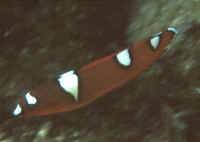
|
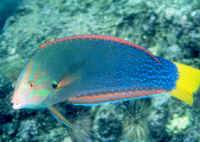
|
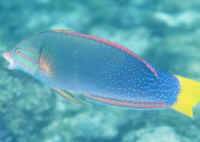
|
|
|
Gomphosus varius Lacepede 1801, is the much more common
Bird Wrasse (1) in the west. Its males are lighter green
over-all, and females transversely white to black front to back,
with an orangish upper "beak". The common Bird Wrasse
is found in Hawaii to the tropical western Pacific and eastern
Indian Ocean. Female in Hawai'i, male in captivity.
|
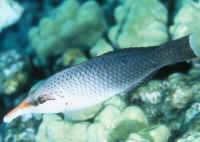
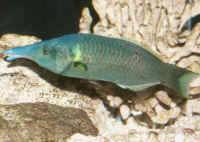
|
|
|
Macropharyngodon geoffroy (Quoy & Gaimard 1824),
Potters Leopard Wrasse (3). Found in Hawai'i to Micronesia
and the East Indies. A look-alike for Potters Dwarf Angelfish,
Centropyge potteri. A very delicate species. Maui and
aquarium photos.
|
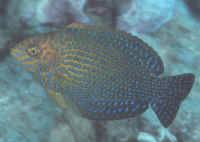
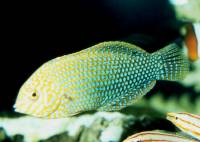
|
|
|
Novaculichthys taeniourus (Lay & Bennett
1839) the Rock Mover, Dragon or Indian Wrasse is a very hardy
fish that is more often killed by aquarists than dies from other
influences. As an aquarium specimen this species requires regular
"beefy" feedings of animal-based foods. It is a
gluttonous feeder that quickly starves if underfed. Not for reef
tanks, To about a foot in length. Juvenile in captivity and
adult in Hawai'i shown.
|
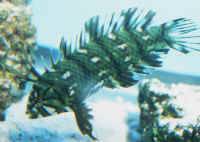
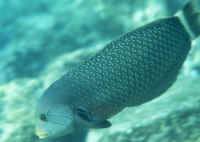
|
|
|
|
|
|
|
|
|
|
|
Deeper Water Surgeonfishes:
|
Ctenochaetus hawaiiensis (Chevron Tang); All
Ctenochaetus species change color with age but the chevron
is most striking. Ctenochaetus hawaiiensis young are
unforgettable; bold orange bodied covered with variegated lines
of electric blue. Adults shift to a deeper orange red base
covered with darkish blue uneven horizontal lines, ultimately to
almost black. Below, juvenile and adult specimens in aquariums
and a splendid adult off of Kailua-Kona, Hawai'i.
|
|
|
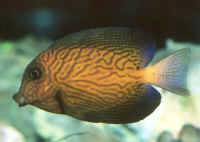
|
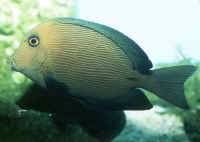
|
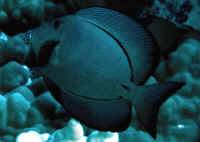
|
|
|
|
|
|
|
An Open Water/Pelagic
Triggerfish:
|
A more open ocean species, the Redtail or Crosshatch
Triggerfish, Xanthichthys mento (Jordan & Gillbert
1882). Entire tropical Pacific. To a foot in length. One in
captivity and a school off of Socorro in the Eastern Pacific.
|
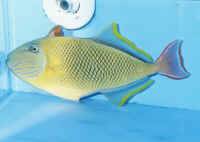
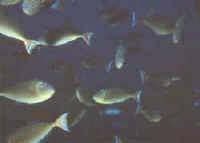
|
Puffers of all kinds:
Boxfishes:
One
of the six species of the bony-encased boxfishes found here finds its
way into the trade regularly, the (male) Blue Box and (female) Black
Boxfish.
|
Ostracion meleagris Shaw 1796, the Blue (male), Black
(female) or Whitespotted Boxfish. Vying with the common Cowfish,
Lactoria cornuta, for most commonly offered species in the
family. Like other (demersal) Boxfish species, this one needs to
be well fed... on the tank bottom, not the surface or mid-water.
Take care with aggressive feeding tankmates. A female and male
from Hawaii in captivity.
|
|
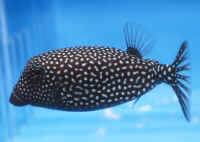
|
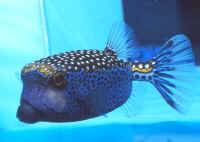
|
Puffers That Blow-Up: True Puffers and
Burrfish
A real mix of large and small (Tobies) species that come into our
interest from HawaiI and elsewhere. Large species for very large
systems only.
|
Arothron hispidus (Linnaeus 1758),
the White-Spotted Puffer. Indo-Pacific, Red Sea, east African
coast, tropical east Pacific coast. To twenty inches in length in
the wild. Cute when small, and very hardy... just big eaters and
mess makers. Here are pictured a four inch juvenile in captivity,
a one foot specimen in the Red Sea, and a fifteen inch mottled or
"koi" one in the Seychelles.
|
|
|
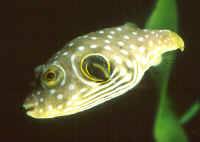
|
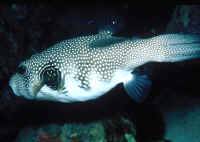
|
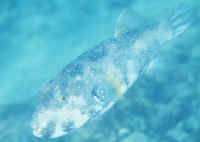
|
|
|
|
|
|
|
|
Arothron meleagris (Lacepede 1798),
the Guinea Fowl Puffer. This is a "standard" offering
in the pet fish trade, in black and white, golden and mottled
color morphs. Found throughout the tropical Indo-Pacific. Below
are images of a "normal" individual in
Hawai'i, a xanthic "gold" one in captivity,
and a mottled "koi" one in Cabo San Lucas, Mexico. To
twenty inches long in the wild.
|
|
|
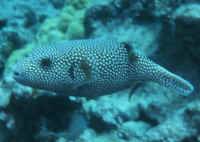
|
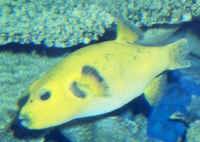
|
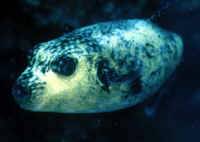
|
|
|
A species regularly offered is the Ambon Sharpnose
Canthigaster amboinensis (Bleeker 1865). I also like the
science of ichthyology's name for this species,
"Spider-Eye Puffer" for obvious reasons. Tropical
eastern Pacific and Indo-Pacific. To six inches long in the wild.
Here's one in captivity, another in Hawai'i..
|
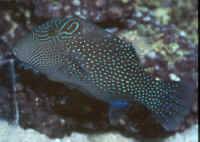 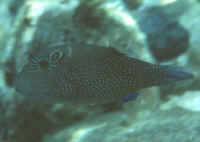
|
|
|
|
|
|
|
|
|
|
Canthigaster coronata (Vaillant & Sauvage 1875),
the Crowned Puffer. Another regular offering from this
genus/subfamily. Indo-west Pacific, Red Sea out to Hawai'i.
To five inches in the wild. This image made off of Gili Air,
Lombok, Indonesia.
|
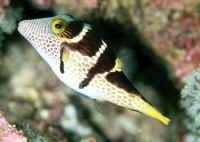
|
|
Canthigaster jactator (Jenkins 1901),
Hawaiian Sharpnose Puffer. Hawaiian endemic. To three inches in
length. This one in the 50th State's waters.
|
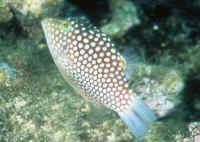
|
|
Diodon holacanthus Linnaeus 1758, the Long-Spined
Porcupinefish. Circumtropical in distribution. To some eighteen
inches in length in the wild. A comical, hardy addition to a
fish-only rough and tumble marine system. Aquarium and St. Lucia
(Caribbean) images.
|
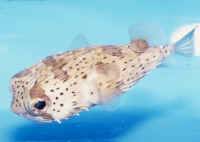
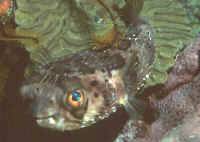
|
|
Diodon hystrix Linnaeus 1758, the Spotted Burrfish.
Circumtropical in distribution. To some three feet in length in
the wild (not a misprint). Here are photos of specimens in
Hawai'i and the Maldives.
|
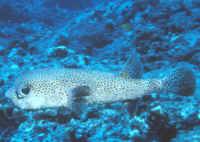
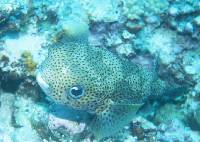
|
Bibliography/Further
Reading:
Fishbase.org (the definitive Net reference for
ichthyological information)
Hoover, John 1998. Hawaiis Sea Creatures. A Guide
to Hawaiis Marine Invertebrates. Mutual Publishing, Oahu. 365 pp.
Randall, John E. 1996. Shore
Fishes of Hawaii. Natural Wonder Press, OR. 216 pp.
To: Part 1, Part
2, Part 3, Part 5, Part
6, Part 7,
|
|

